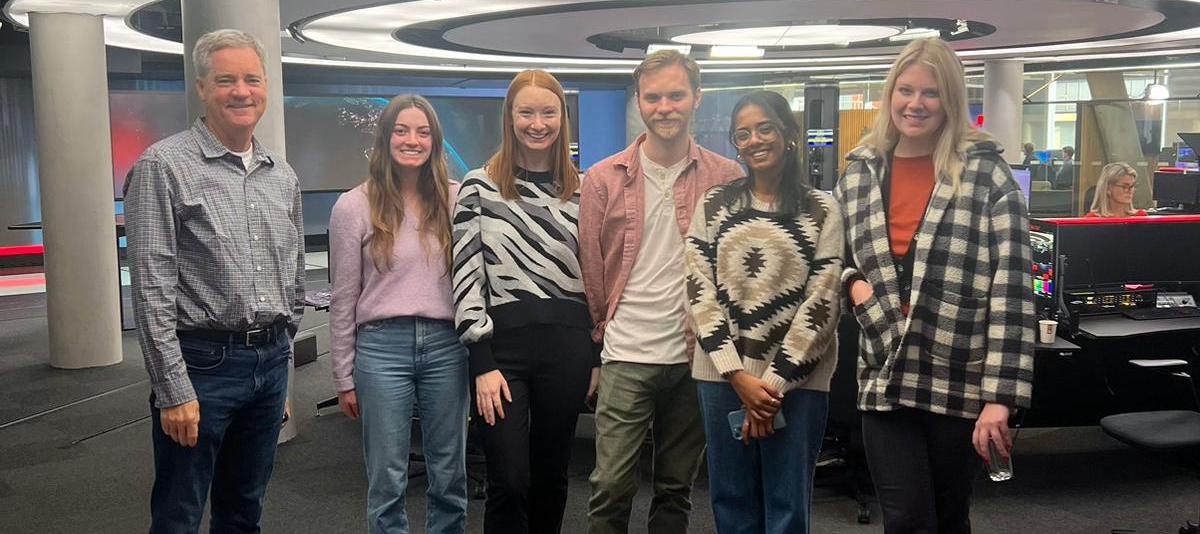BRIJ: Bridging Investigative Journalism. A global perspective to uphold essential principles of a sustainable democracy
In a world where democracy is being threatened by the accelerated loss of local journalism, it is not uncommon for communities to be left with fake news and polarizing biases. The need for journalists who can understand global challenges and extrapolate these into local contexts is now more relevant than ever. The University of Bergen (UiB), the American University (AU), and the Nordic Press Center in Washington (NPC) have partnered up to tackle these challenges through the BRIJ project.
Recently edited: 2. December 2025
Students visiting the studio at TV2
Foto: SUJO, UiBAbout the project
Responsible: Regine Olsen-Hagen, University of Bergen
Duration: 11, 2022 - 10, 2026
Area: Media studies and journalism, Higher education and research, Working life and skills
Parterns: American University (US), Nordic Press Center (NPC, US)
Funding: 2 977 407 NOK
Background
Bridging Investigative Journalism (BRIJ) is a mobility program between Investigative Journalism Master’s students at the University of Bergen (UiB) and Journalism Master’s students at the American University (AU) in Washington, DC.
BRIJ’s goal is simple but powerful: to produce “world-class journalists not only capable of exposing local and international structures hampering our search for a sustainable future, but also capable of finding those stories that feed humanity with hope for a sustainable future” - BRIJ.
Participants
BRIJ brings together a journalism dream team with this amazing partnership between Norway and the US. With prominent participants and leaders in their field, BRIJ offers a unique opportunity for students to gain knowledge from renowned experts. Through BRIJ, students can take part in a highly curated program that aims to broaden their experiences and enables them to apply their learnings in relevant international contexts.
Activities
Every year, five journalism students from the American University in Washington DC exchange places with five UiB’s journalism master's students in Bergen. During their stay, students take part in lectures, seminars, and professional meetings with journalists and editors at national and local levels.
Additionally, since visits are planned to happen consecutively, the students from both universities can interact and take part in the activities for the visiting group, enriching the overall experience and fostering sustainable research collaboration.
Results
In a refreshing new take, BRIJ lets the most important participants of the project lead the way in evaluating its impact: the students. Via investigative projects, interviews, and networking events (to name a few choices), BRIJ’s students will have many opportunities to share their experiences, practice their skills, and gain relevant journalistic exposure.
Student’s perspectives:
- Emil Andreas Malmin Nordpoll (master’s degree student in Investigative Journalism at the University of Bergen): “I wasn't quite sure what to expect, but looking back on it, I don't regret a thing. I learned so much about American politics and American culture. Capitol Hill and Washington, D.C. are certainly a place I want to visit once more, at least.”
- Julian Mællingsæter (master’s degree student in Investigative Journalism at the University of Bergen): “The BRIJ program gave me the best and most intense three weeks of my student life. I learned a lot from all the people we talked to during the program. Inspirational.”
- Nick Fogleman (master’s degree student in Journalism and Public Affairs at the American University): "Engaging in this exchange program reshaped my career trajectory as a student. It broadened my worldview and deepened my cultural appreciation. It catalyzed personal growth and equipped me with essential skills and perspectives that I hope to use in my future career."
Advice
- Reach out to potential project partners at an early stage. Listen to their ideas and invite them to contribute to the application and content of the project.
- Usually partners in other parts of the world have different approval protocols that depend on people who are not necessarily part of the project. Make them aware of the project and include the duration of these tasks in the timeline of your submission process. You don’t want to be close to the deadline and be running after signatures!
- If you are new to the interface of Espresso (the application and reporting portal of HK-Dir), get familiar with the outline and the maximum character limits of each section. Do not bother writing fancy documents in word.